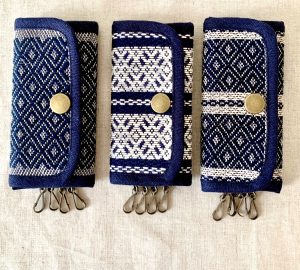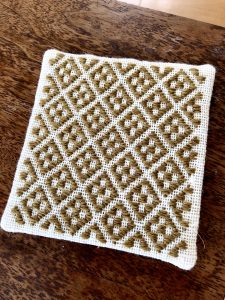無心になる時間(愛知県名古屋市千種区姫池通 骨董買取 古美術風光舎)
2023.07.09
皆さまこんにちは。スタッフHでございます。
湿気の多い日が続きますね。
皆さまは気晴らしになるような趣味などはお持ちでしょうか。
私は定期的に何かに没頭したくなる時があり、かぎ針や刺し子など同じ動作を繰り返すものが性に合っているようで、忘れたころに道具を引っ張り出してきます。
制作意欲があるわけではなく、ひたすら手を動かすことで無心になり、頭を空っぽにします。
他の用事が手につかなくなりますが…。
数年前に青森県つがるの「こぎん刺し」を習う機会がありました。
先生の素晴らしい作品です。

そして恥ずかしながら自作のつたないコースターです。
興味本位で始めたこぎん刺しですが、今回その歴史について調べてみました。
青森県津軽の「こぎん刺し」は青森県南部乗「菱刺し」、山形県庄内の「庄内刺し子」と並び日本の三大刺し子と呼ばれています。
北国の津軽では綿の栽培が困難なため一般に使用される衣服の多くは麻布でできていました。
1724年に出された「農家倹約分限令」により農民は仕事着はもちろんのこと、被り物、肌着、帯にいたるまで細かく規制されていました。
木綿の着用を許されなかった農民は麻布を重ねて麻糸で刺した着物を普段着としていました。
農作業では重い籠を背負うので、擦り切れやすい肩や背中を糸で刺すことにより摩耗を防ぎました。
また糸を密に刺すことで保温効果も高めていました。
津軽こぎん刺しは農民が家族の健康を守るために厳しい制約の中で補強と保温を目的に作り出された暮らしの知恵でした。
明治に入ると木綿の着用が解禁になります。木綿糸が手に入りやすくなり、こぎん刺しも藍色の麻布に白い木綿糸で刺されるようになっていきます。
農家の女たちの美意識と工夫で多くの模様が生み出され、他の刺し手と美しさを競い合うようになり、また娘たちは幼少から刺す練習をし、晴れ着用として嫁入り支度には欠かせないものとなりました。
江戸後期に花開いたこぎん刺しですが、明治維新を経て木綿が流通するようになると、人々は暖かな木綿素材を好むようになり、麻を素材とした技法は一時途絶えました。
昭和に入ると、柳宗悦(やなぎむねよし)らによる民芸運動により伝統工芸品として注目を浴びるようになりました。
宗悦はつがるこぎん刺しの模様に注目し民家や古道具屋で昔のこぎん着物を収集し次のように絶賛しました。
「名もない津軽の女たちよ、よくこれほどのものを遺してくれた。・・・虐げられた禁制のなかで是程の美しいものを産んでくれた」
ただ糸を刺すことは長い冬の間の仕事のひとつでもあり、また娯楽のひとつでもあったようです。
厳しい生活の中でもものを作る喜びを感じ、誰も刺せないような模様を刺せることが当時の若い娘の願いでもあり、途絶えた後もどうしても止めることができない女性もいたようです。
現在も独特な幾何学模様「モドコ」や色とりどりの糸や布を用いて、無数のバリエーションが日々生み出されています。
歴史を知ると、また糸を刺す感覚も違ってきそうです。
それでは、またお会いしましょう。
Hello everyone. This is Staff H.
The humid days are continuing.
Do you have any hobbies or interests that help you relax?
I have times when I want to devote myself to something regularly, and crocheting, stitching, and other things that require repetition of the same actions seem to suit my nature, and I pull out my tools when I forget about them.
I don’t have a strong desire to create, but I just move my hands around and get lost in it, emptying my mind.
I am not able to do anything else, though.
A few years ago, I had a chance to learn “Kogin Sashimi” from Tsugaru, Aomori Prefecture.
It is a wonderful work of the teacher.
And I am ashamed to say that it is a clumsy coaster of my own making.
I started to learn Kogin Sashimi just out of curiosity, but this time I looked into its history.
Kogin stitch” in Tsugaru, Aomori Prefecture, is called one of the three major types of sashiko in Japan, along with “Hishi stitch” in Nanbu, Aomori Prefecture, and “Shonai stitch” in Shonai, Yamagata Prefecture.
In the northern region of Tsugaru, where cotton is difficult to grow, most of the clothing used by the general public was made of hemp cloth.
In 1724, the “Farmer’s Thrift Restriction Ordinance” regulated not only work clothes but also coverings, undergarments, and even sashes.
Farmers who were not allowed to wear cotton wore a linen kimono, which was made by layering linen cloth and stitching it with hemp thread, as their daily wear.
Since farmers carried heavy baskets on their backs, they prevented abrasion by stabbing their shoulders and backs with threads, which were prone to fraying.
The dense stitching of the threads also helped to keep the wearer warm.
Tsugaru Kogin Sashimi was a way of life created by farmers to protect the health of their families by reinforcing and keeping them warm under severe restrictions.
In the Meiji era (1868-1912), the ban on the wearing of cotton was lifted. Cotton thread became more readily available, and kogin stitching began to be done with white cotton thread on indigo-colored linen.
The women of the farming households created many patterns with their aesthetic sense and ingenuity, and began to compete with other stitchers in terms of beauty.
Kogin-sashi flourished in the late Edo period (1603-1868), but after the Meiji Restoration (1868-1912), when cotton came into circulation, people preferred the warmth of cotton, and the technique using hemp temporarily died out.
In the Showa period (1926-1989), hemp became the focus of attention as a traditional craft due to the folk craft movement led by Yanagi Muneyoshi and others.
Muneyoshi Yanagi paid attention to the patterns of Tsugaru kogin stitching and collected old kogin kimonos from private homes and antique shops, praising it as follows
She collected old kogin kimonos from private homes and antique shops, and praised them as follows: “Women of Tsugaru, who have no names, have done well to leave us such a great legacy. You have given birth to something so beautiful in the midst of oppression and prohibition.
Stitching thread was both work and recreation during the long winter months.
Even in the midst of a hard life, young girls of that time felt the joy of making things and were able to stitch patterns that no one else could stitch, which was a wish of young girls.
Even today, countless variations are created daily using unique geometric “modoko” patterns and colorful threads and fabrics.
Knowing the history, you may feel differently when stabbing the threads.
See you again soon.
*******************
ご実家の整理やお片付けなどをされている方のご相談などが多くございます。
お片付けなどくれぐれもご無理のないようになさってくださいませ。
風光舎では古美術品や骨董品の他にも絵画や宝石、趣味のお品など様々なジャンルのものを買受しております。
お片付けをされていて、こういうものでもいいのかしらと迷われているものでも、どうぞお気軽にご相談下さいませ。
また風光舎は、出張買取も強化しております。ご近所はもちろん、愛知県内、岐阜県、三重県その他の県へも出張いたします。
まずは、お電話お待ちしております。
愛知県名古屋市千種区姫池通
骨董 買取【古美術 風光舎 名古屋店】
TEL052(734)8444
10:00-17:00 OPEN
#出張買取#骨董#古美術#骨董品#絵画#版画#茶道具#刀剣#彫刻


